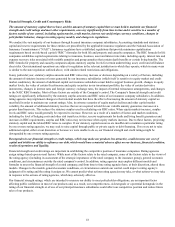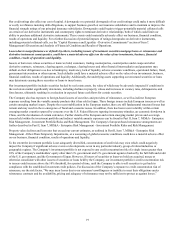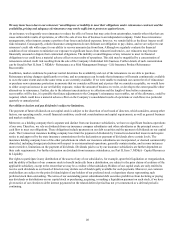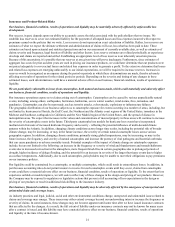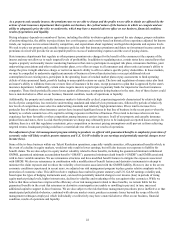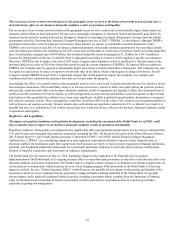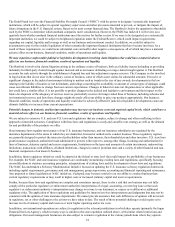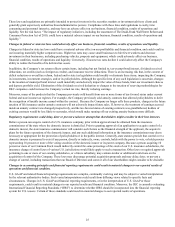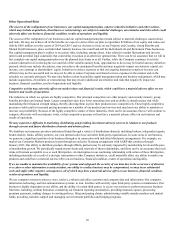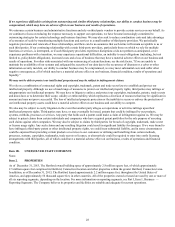The Hartford 2013 Annual Report Download - page 28
Download and view the complete annual report
Please find page 28 of the 2013 The Hartford annual report below. You can navigate through the pages in the report by either clicking on the pages listed below, or by using the keyword search tool below to find specific information within the annual report.28
If we experience difficulties arising from outsourcing and similar third-party relationships, our ability to conduct business may be
compromised, which may have an adverse effect on our business and results of operations.
We outsource certain business and administrative functions and rely on third-party vendors to provide certain services on our behalf. As
we continue to focus on reducing the expense necessary to support our operations, we have become increasingly committed to
outsourcing strategies for certain technology and business functions. We may also seek to reduce coordination costs and take advantage
of economies of scale by transitioning multiple functions and services to a small number of third-party providers. We periodically
negotiate provisions and renewals of these relationships, and there can be no assurance that such terms will remain acceptable to us or
such third parties. If our continuing relationship with certain third-party providers, particularly those on which we rely for multiple
functions or services, is interrupted, or if such third-party providers experience disruptions or do not perform as anticipated, or we
experience problems with a transition, we may experience operational difficulties, an inability to meet obligations (including, but not
limited to, policyholder obligations), increased costs and a loss of business that may have a material adverse effect on our business and
results of operations. For other risks associated with our outsourcing of certain functions, see the risk factor, “If we are unable to
maintain the availability of our systems and safeguard the security of our data due to the occurrence of disasters or a cyber or other
information security incident, our ability to conduct business may be compromised, we may incur substantial costs and suffer other
negative consequences, all of which may have a material adverse effect on our business, financial condition, results of operations and
liquidity.”
We may not be able to protect our intellectual property and may be subject to infringement claims.
We rely on a combination of contractual rights and copyright, trademark, patent and trade secret laws to establish and protect our
intellectual property. Although we use a broad range of measures to protect our intellectual property rights, third parties may infringe or
misappropriate our intellectual property. We may have to litigate to enforce and protect our copyrights, trademarks, patents, trade secrets
and know-how or to determine their scope, validity or enforceability, which represents a diversion of resources that may be significant in
amount and may not prove successful. The loss of intellectual property protection or the inability to secure or enforce the protection of
our intellectual property assets could have a material adverse effect on our business and our ability to compete.
We also may be subject to costly litigation in the event that another party alleges our operations or activities infringe upon their
intellectual property rights. Third parties may have, or may eventually be issued, patents that could be infringed by our products,
systems, methods, processes or services. Any party that holds such a patent could make a claim of infringement against us. We may be
subject to patent claims from certain individuals and companies who have acquired patent portfolios for the sole purpose of asserting
such claims against other companies. We may also be subject to claims by third parties for breach of copyright, trademark, trade secret
or license usage rights. Any such claims and any resulting litigation could result in significant liability for damages. If we were found to
have infringed a third-party patent or other intellectual property rights, we could incur substantial liability, and in some circumstances
could be enjoined from providing certain products or services to our customers or utilizing and benefiting from certain methods,
processes, systems, copyrights, trademarks, trade secrets or licenses, or alternatively could be required to enter into costly licensing
arrangements with third parties, all of which could have a material adverse effect on our business, results of operations and financial
condition.
Item 1B. UNRESOLVED STAFF COMMENTS
None.
Item 2. PROPERTIES
As of December 31, 2013, The Hartford owned building space of approximately 2.8 million square feet, of which approximately
2.5 million square feet comprised its Hartford, Connecticut location and other properties within the greater Hartford, Connecticut area.
In addition, as of December 31, 2013, The Hartford leased approximately 2.2 million square feet, throughout the United States of
America, and approximately 56 thousand square feet, in other countries. All of the properties owned or leased are used by one or more of
all six reporting segments, depending on the location. For more information on reporting segments, see Part I, Item 1, Business —
Reporting Segments. The Company believes its properties and facilities are suitable and adequate for current operations.


